Apr
10
2009
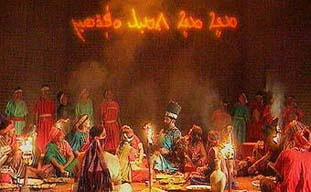
Belshazzar curses the day he let the Chaldeans talk him into signing up with Facebreadbook.
“In the same hour the fingers of a man’s hand appeared and wrote opposite the lampstand on the plaster of the wall of the king’s palace; and the king saw the part of the hand that wrote.” Daniel 5:5
“The fact that the Watcher Lampstand oversees the Facebread in the Temple means that Israel undergoes a continual inspection of jealousy. God watches all the time. In Daniel 5, the Lampstand “arrives” and sees Belshazzar’s face, “facebread” because it is at his great “bread”, and his face is undone as his “splendours change”. It is precisely as Belshazzar is drinking the wine that the judgment appears, as in the case of the woman in Numbers 5. As a priestly agent is involved in bringing judgment in Numbers 5, so Daniel is involved in bringing judgment in Daniel 5. As the woman’s loins are undone, so are Belshazzar’s. The woman’s judgment is barrenness; in the case of Belshazzar the king, the judgment is the same: no future.”1
Notice the “Holy Place” configuration. The Lampstand, the Table, and the graven Word (Ark). Daniel is the Incense Altar, the accepted elder. Why do pictures of this event never include the Lampstand? It is crucial.
_____
1 James B. Jordan, The Handwriting on the Wall, p. 289.
See also Jesus at Belshazzar’s Feast: An Explanatory Disquisition on an Aspect of the Story of the Woman Taken in Adultery for an interesting read.
Comments Off | tags: Babylon, Belshazzar, Daniel, James Jordan, Lampstand | posted in The Restoration Era
Apr
10
2009
“Behold, the day of the LORD comes, Cruel, with both wrath and fierce anger, To lay the land desolate; And He will destroy its sinners from it. For the stars of heaven and their constellations Will not give their light; the sun will be darkened in its going forth, and the moon will not cause its light to shine.”
You’ll never understand a book if you only ever read the last chapter. If you thought this quote was from the New Testament you are almost right. It is from Isaiah 13, and Jesus quotes it. It begins: “The burden against Babylon which Isaiah the son of Amoz saw…”
Would Jesus’ audience have thought He was referring to the destruction of the cosmos? Nup. They would (or should) have realised that He was calling Judah a new Babylon, and that the “sun, moon and stars”, the governing lights of her kingdom were about to come crashing down.
Jesus had a sharp mind, and a sharp mouth. A lot sharper than us when we misinterpret Matthew 24.
Comments Off | tags: Apocalyptic, Babylon, Hermeneutics, Isaiah | posted in The Last Days
Apr
10
2009
Saul and Agag
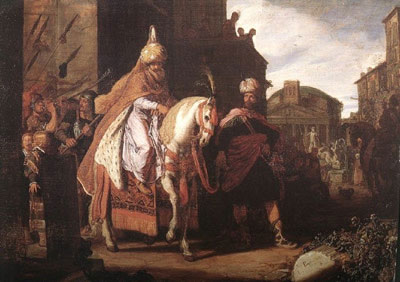 I puzzled over Ezekiel chapters 38 and 39 for years. Bible commentators suggested many things but nothing seemed to fit the historical context of the surrounding chapters. It seems James B. Jordan was the first to put the pieces together.1
I puzzled over Ezekiel chapters 38 and 39 for years. Bible commentators suggested many things but nothing seemed to fit the historical context of the surrounding chapters. It seems James B. Jordan was the first to put the pieces together.1
Continue reading
Comments Off | tags: Amalek, Atonement, Babylon, Bible history, Esther, Ezekiel, Gary DeMar, Haman, James Jordan, Mordecai, Saul, Typology | posted in Against Hyperpreterism, Biblical Theology, The Last Days, Totus Christus
Apr
10
2009
Greater Solomon
The structure of Revelation passes through two large heptamerous cycles (1-11 and 12-19). But the book as a whole follows the same pattern as Ezekiel. In the last three chapters, following Ezekiel’s pattern, John is shown the destruction of Gog (Amalek) in the Land, and a vision of a new Jerusalem. However, unlike Ezekiel, these events are beyond the second cycle of the book, and for good reason. This final “east-west” section exiles the Accuser to the Abyss (Azal) and enthrones the Bride. It is the only part of Revelation that directly concerns our own day.
Continue reading
Comments Off | tags: AD70, Amalek, Ark of the Covenant, Babylon, Millennium, Moses, Postmillennialism, Revelation, Solomon, Temple, Typology, Zechariah | posted in Against Hyperpreterism, Biblical Theology, The Last Days
Apr
10
2009
Did God replace Judaism or merely put it on hold?
Being a Jew was never a matter of bloodline, but of Covenant. Think of Abraham’s servants circumcised in Genesis 17, the Egyptians at the Exodus, Caleb the Kenizzite, Rahab, Ruth, Uriah, etc. It seems the Old Testament keeps throwing us examples of people “grafted in.” The only actual bloodline of any importance is the one we are given, the family tree from Abraham to Christ.
Israel’s captivity and Restoration gave us a perfect picture of the New Covenant events. The Temple and walls of the old Israel were ‘de-created’ and God Himself (the ark) died in Babylon for the sake of a new Jerusalem with impregnable walls.
Christ was the human ark. Judaism, intermarried with Roman political power, became Babylon.
My point is, the captivity was a death-and-resurrection of first century Israel (the resurrection as predicted in Ezekiel 37) in type. The first century was the antitype. Thus, whatever remains of Judaism today is like exhumed idols from the eras of Jeroboam, Ahab*, Omri and Manasseh.
It is not about blood. It never was. It is about Covenant, and there is only one of those. Despite its various death-and-resurrection renewals, there has only ever really been one covenant. There is no replacement of God’s people, only transfiguration from glory to glory.
*Remember it was Jezebel’s daughter Athaliah that almost DID destroy this single bloodline that mattered. Jehoash was the single son who escaped, an echo of Moses and a type of Christ.
6 comments | tags: Abraham, Ahab, Ark of the Covenant, Athaliah, Babylon, Covenant curse, Dispensationalism, Genesis, Jezebel, Joash, Replacement Theology, Resurrection, Ruth | posted in Biblical Theology
Apr
10
2009
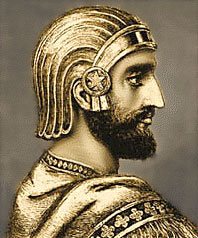 For the ancient world, a garden, a house, a city or a temple was like a woman. An invading army, after storming through the gates of a city, would rape the virgins. It was a brutal reminder that, like the women, the conquered city was not impregnable.
For the ancient world, a garden, a house, a city or a temple was like a woman. An invading army, after storming through the gates of a city, would rape the virgins. It was a brutal reminder that, like the women, the conquered city was not impregnable.
“In order to understand this, we have to think like ancient Hebrews, and not like modern people… Adam was supposed to guard the garden, and he was also supposed to guard his wife.
The Song of Solomon compares the woman to a garden several times in the course of the book. In all languages, the words for city, garden, and the like are feminine, and we speak of a city as “she” in English today.
Let us take a look at the city in the Bible, remembering that what is said of the city is also true of the house, tent, Temple, Tabernacle, and other enclosed homes for humanity. The city has walls and gates. The purpose of these walls and gates is to keep the enemy out. The goal is that the city be impregnable, and note that English word – it directly connects the city with the woman. Thus, the city has to be a virgin, sealed against attack. Jerusalem is referred to as an impregnable virgin repeatedly in Scripture (2 Kings 19:21; Is. 37:22; Jer. 14:17; 18:13; Jer. 31:21; Amos 5:2). The attack on Jerusalem is thus the rape of a city (Lam. 1:15; 2:13)… Just as Eve was “built” from Adam (using an architectural term, Gen. 2:22), so Jerusalem would be rebuilt as a virgin (Jer. 31:4)… Thus, the safety and security of the virgin daughters of Israel was a symbol of the safety and security of the whole land. Their inviolability corresponded to the inviolability of the whole culture (Lam. 1:4; 2:10).”
In the case of Babylon, its walls and gates were impregnable. The city was built on the Euphrates river, which ebbed into the city under the wall. Even the banks of the river were protected by metal gates from any invaders who could hold their breath long enough. Under Belshazzar, Babylon lost her virginity (Isaiah 47:1-3), and during the feast her river gates had been left open.
In a brilliant military manoeuvre, Cyrus the Great gave the signal for his troops upstream to divert the river. The invading army marched into the city dryshod and took it with little resistance. There were hints of this in the prophecies of both Isaiah (44:27) and Jeremiah (50:38, 51:36). The waters of the bringer of the “flood” were dried up. The Land was rising from the deep.
___________________
James B. Jordan (concerning the virginity of Jephthah’s daughter), Judges: God’s War Against Humanism, p. 211-212. Download from www.biblicalhorizons.com
Comments Off | tags: Babylon, Belshazzar, Cyrus, Greater Eve, James Jordan, Judges | posted in Biblical Theology, The Restoration Era, Totus Christus
Apr
10
2009
“Then the sixth angel blew his trumpet, and I heard a voice from the four horns of the golden altar before God, saying to the sixth angel who had the trumpet, “Release the four angels who are bound at the great river Euphrates.” Revelation 9:13-14
To purify the Land of the sins of the nation or the High Priest, the horns of the Incense Altar were smeared with blood from the sacrifice at the bronze Altar. These four angelic commanders, who were previously held back, were horns looking for blood.*
The fifth trumpet, alluding to Joel 2, had summoned clouds of Babylonian locusts (Judaisers) with hair like women (false Nazirites) from Herod’s false altar to devour the Land. Like those in Joel, these are ‘mighty men,’ the result of the compromise of the sons of God with idolatry (Genesis 6).
Now, the sixth trumpet brought a response from the true Altar of Incense—an unimaginable cloud of true Nazirites. The position of this event in the structure of the passage alludes to Joshua’s conquest of Canaan. But as a ‘Trumpet’, this was only a warning. The sixth bowl would bring the final conquest: Armageddon.
The sixth angel poured out his bowl on the great river Euphrates, and its water was dried up, to prepare the way for the kings from the sunrise.
Like the Jews returning from Babylon, and Abraham when he first entered Canaan, they crossed the great river Euphrates in their baptism into Christ. Just as Cyrus “parted” the Great River to conquer Babylon, the river of death was parted to allow the true saints to inherit the heavenly country. Old Jerusalem became Jericho – the city devoted to destruction.
This was an army of true Nazirites who had not broken their vow:
These are the ones who were not defiled with women, for they are virgins. These are the ones who follow the Lamb wherever He goes. These were redeemed from among men, being firstfruits to God and to the Lamb. (Revelation 14:4)
Instead of storming the open gates and raping the virgins, here an army of “virgins” crossed the Euphrates, stormed into Babylon and purified the daughters of men culture around them.
(*This refers to the Hebrew for corners and commanders being the same word.)
Comments Off | tags: Babylon, High Priest, Incense Altar, Joshua, Nazirite, Revelation | posted in Biblical Theology, The Last Days, Totus Christus
Apr
10
2009
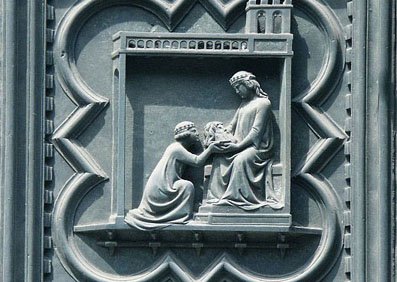
Peter Leithart observes that both Esther and Herodias’ daughter are promised up to “half the kingdom.”
There are echoes in the story of the book of Esther, at least in Mark’s version of John’s execution. Matthew tells us that when the daughter of Herodias danced before Herod, he promised with an oath to give whatever she asked. Mark records Herod’s words somewhat differently: He promises not just to give what she asks, but promises to give up to half his kingdom (Mark 6:22-23). This is the same promise that Ahasuerus gives to Esther when she says she has a request for him (5:3, 6).
In both passages, we have a woman, a queen, requesting something from a king. In both stories, we have a king promising half his kingdom. We could even say that both Esther and Herodias are asking for someone’s head. Esther knows that Haman is plotting to kill all the Jews, and she is asking for his life in order to protect the Jews.
But there the similarities end. Esther appeals to the king to save the faithful in Israel, while the daughter of Herodias is instructed instead to ask for the head of a faithful man, albeit a troubler of Herod’s kingdom, a prophet who has made life difficult for Herod because of his faithfulness. Instead of being like the protective Ahasuerus in Esther, Herod is more like Haman, seeking to wipe out the true Israel.
http://www.leithart.com/2008/06/21/herodias-and-esther/
Esther, like Deborah, and Jael, typifies Mary, the warrior bride whose offspring would crush the head of the serpent. A Nazirite growing his hair during a ‘holy war’ vow identified him with submission and purity. John uses Nazirite symbols to describe the bad Nazirites, the Judaising “locusts” troubling the church.
“And they had hair as the hair of women, and their teeth were as the teeth of lions.” Revelation 9:8 (and Joel 1:6)
They were negative-Nazirites, men who had taken vows to destroy the apostles (Acts 21:23). With the charm (and hair) of an army of Absaloms, their holy war was stamping out the Son of David. They were the false warrior bride, Herodias, seeking the head of the true Nazirite, Christ, in revenge for the victory over Goliath at the cross. This Herodias-Jezebel-Babylon of superseded Judaism would wipe out the true Israel at any cost.
Comments Off | tags: Babylon, Esther, goliath, Herodias, Jezebel, Nazirite, Peter Leithart | posted in Biblical Theology
Apr
10
2009
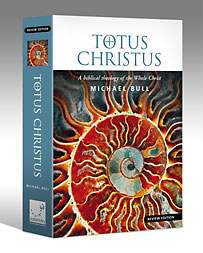 Nebuchadnezzar fought hard against historical Tyre, but was not able to plunder it. Was Ezekiel wrong? Or does Ezekiel’s prediction of Tyre’s total destruction support the identification of the subject of this prophesy as Judah? It was Judah whose (bronze) pillars were brought down and her foundations made a bare rock. The Lord would instead pay his faithful Babylonian “servant” with the riches of Egypt (29:19-20).
Nebuchadnezzar fought hard against historical Tyre, but was not able to plunder it. Was Ezekiel wrong? Or does Ezekiel’s prediction of Tyre’s total destruction support the identification of the subject of this prophesy as Judah? It was Judah whose (bronze) pillars were brought down and her foundations made a bare rock. The Lord would instead pay his faithful Babylonian “servant” with the riches of Egypt (29:19-20).
The imagery of Pharaoh’s descent to Sheol in chapter 32 has the Exodus in mind. Egypt’s armies would be swallowed by Babylon in the way Pharaoh’s armies drowned in the Red Sea. All the uncircumcised nations would welcome him to hell, and Egypt is the last army to be drowned and made unable to cross over into the new world the Lord was creating.
Of the imagery reprised in Revelation, the foremost is that of a dragon of the Nile, most likely a crocodile. Pharaoh thought he was secure in the fertility of the river, but the Lord would put hooks in his jaws and throw him into the wilderness. The crocodile would be food for birds and beasts, a Covenant curse. Ezekiel is once again making a veiled insult against the king of Israel, using Pharaoh’s behaviour as an object lesson. Israel’s mission was to bring the river of life to the nations but she had instead brought them harm. Like the real Egypt, the nations had leaned on Israel as a crutch, and she had only brought them injury. For this, Egypt/Israel would be made desolate, then restored from captivity. But because she had usurped the Lord’s throne, she would forever be a vassal kingdom.
As Tyre, Solomon’s gold was stolen by foreigners. As Sidon, his oppressive taxation was cut off. And as Egypt, his many wives were taken captive and the horses he had imported from Egypt were finally drowned in the sea. The word of the Lord is sure.
Comments Off | tags: Babylon, Ezekiel, Nebuchadnezzar, Pharaoh, Revelation, Tyre | posted in Biblical Theology, Totus Christus
Apr
9
2009
And the LORD said, “Arise, anoint him, for this is he.” Then Samuel took the horn of oil and anointed him in the midst of his brothers. And the Spirit of the LORD rushed upon David from that day forward. And Samuel rose up and went to Ramah.
Now the Spirit of the LORD departed from Saul, and a harmful spirit from the LORD tormented him. And Saul’s servants said to him, “Behold now, a harmful spirit from God is tormenting you. Let our lord now command your servants who are before you to seek out a man who is skillful in playing the lyre, and when the harmful spirit from God is upon you, he will play it, and you will be well.” (1 Sam. 16:12-16)
Does God send evil spirits? …
Continue reading
Comments Off | tags: Babylon, Covenant curse, David, Herod, Jeff Meyers, Pharaoh, Satan, Saul, Temple | posted in Biblical Theology






























